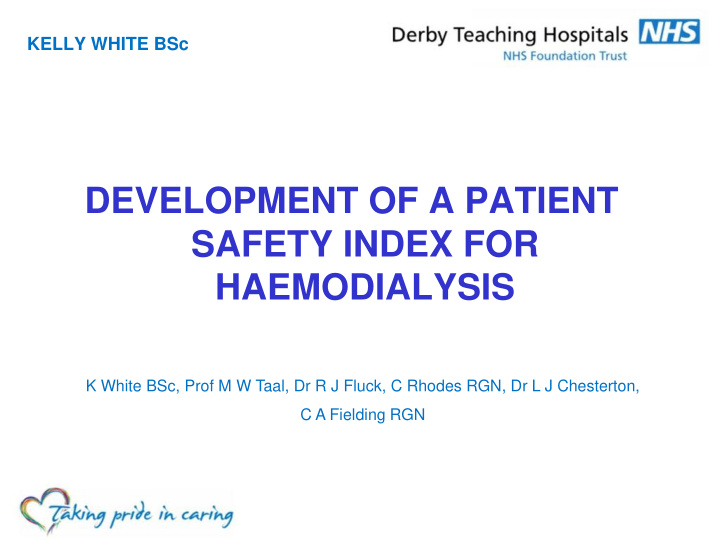



KELLY WHITE BSc DEVELOPMENT OF A PATIENT SAFETY INDEX FOR HAEMODIALYSIS K White BSc, Prof M W Taal, Dr R J Fluck, C Rhodes RGN, Dr L J Chesterton, C A Fielding RGN
INTRODUCTION • Haemodialysis is a widely used therapy that is associated with multiple risks for patients such as; • Adverse reactions • Problems with vascular access • Incidents related to extracorporeal circuit • Errors in treatment performance • Monitoring can improve patient experience
BACKGROUND DERBY HOSPITALS: HAEMODIALYSIS TRIGGER TOOL Category E: contributed to or resulted in temporary harm to the patient & required intervention Category F: contributed to or resulted in temporary harm to the patient & required initial or prolonged hospitalisation Category G: contributed to or resulted in permanent patient harm Category H: required intervention to sustain life Category I: contributed to the patient's death GENERAL CARE MODULE Trigger ? Severity Code Trigger (1 ) (E-I) Brief Description G1 Vomiting G2 Fever >38C G3 Symptomatic hypotension G4 Loss of consciousness G5 Unplanned admission post HD G6 Chest pain G7 Cardiac arrest G8 Cardiac arrhythmia G9 Emergency medical assessment G10 Blood transfusion G11 Oxygen therapy G12 Fall pre or post HD G13 Cramps without hypotension VASCULAR ACCESS MODULE y Haemodialysis trigger tool Allows regular monitoring of adverse incidents Outlines triggers specific to haemodialysis Identifies areas of recurrent harm y d y y
HAEMODIALYSIS TRIGGER TOOL Has identified areas of frequent harm Interventions used to reduce harm risk Limitations – Complex design – Time consuming – Small number of treatments can be audited
AIMS Develop a simplified tool Allow audit of more treatments Based on results of HTT Treatment areas discussed
DERBY PATIENT SAFETY INDEX FOR HAEMODIALYSIS PUT PICTURE OF DPSI HERE! Pilot performed over 1 week in April 2016 All treatments audited Staff given questionnaire to complete
RESULTS 592 treatments audited over 6 days 111 adverse incidents (19%) – Hypotension = 43 ( 7% ) – Multiple cannulation attempts =26 ( 4.3%) – Reduced HD time =29 ( 5% ) – Hypoglycaemia =10 ( 1.7% ) – Prescription errors = 3 ( 0.5% ) – VND = 0
QUESTIONNAIRE RESULTS Q1 How easy did you find the 25 patients safety index to use? 20 15 Q2 How easy did you find the index to understand? 10 5 Q3 How easy were you able to interpret the definitions of each 0 Q1 Q2 Q3 category? 1 2 3 4 5 Approximately how long did it take 1 = DIFFICULT 5 = EASY to complete the index? – Answers ranged from 20s per patient to 2 minutes per patient
Easy to Drop down use Straight menus forward Hypotension and Gives multiple auditable cannulation columns data Different place to vital data VND CATEGORY Duplication UNNECESSARY
CONCLUSION Easy and simple to use Allows audit of potentially all treatments Highlights frequent harms allowing the introduction of strategies to reduce them Encourages staff vigilance and focussed interventions to prevent harm events Provides a rounded approach to patient safety during haemodialysis treatment We hope that other dialysis providers will consider adopting the DPSI to improve patient safety
WHAT NEXT? Continue with regular audits Integrate with current IT system Respond to changes in frequency of harm events Improve patient experience of haemodialysis
Thank you Any Questions? kelly.white@nhs.net
Recommend
More recommend